Input interpretation

H_2SO_4 sulfuric acid + Na_2SiO_3 sodium metasilicate ⟶ Na_2SO_4 sodium sulfate + H_2O_3Si metasilicic acid
Balanced equation
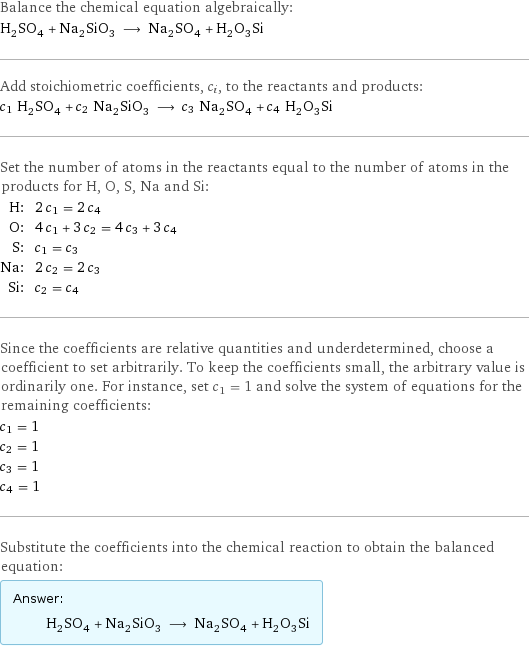
Balance the chemical equation algebraically: H_2SO_4 + Na_2SiO_3 ⟶ Na_2SO_4 + H_2O_3Si Add stoichiometric coefficients, c_i, to the reactants and products: c_1 H_2SO_4 + c_2 Na_2SiO_3 ⟶ c_3 Na_2SO_4 + c_4 H_2O_3Si Set the number of atoms in the reactants equal to the number of atoms in the products for H, O, S, Na and Si: H: | 2 c_1 = 2 c_4 O: | 4 c_1 + 3 c_2 = 4 c_3 + 3 c_4 S: | c_1 = c_3 Na: | 2 c_2 = 2 c_3 Si: | c_2 = c_4 Since the coefficients are relative quantities and underdetermined, choose a coefficient to set arbitrarily. To keep the coefficients small, the arbitrary value is ordinarily one. For instance, set c_1 = 1 and solve the system of equations for the remaining coefficients: c_1 = 1 c_2 = 1 c_3 = 1 c_4 = 1 Substitute the coefficients into the chemical reaction to obtain the balanced equation: Answer: | | H_2SO_4 + Na_2SiO_3 ⟶ Na_2SO_4 + H_2O_3Si
Structures

+ ⟶ +
Names

sulfuric acid + sodium metasilicate ⟶ sodium sulfate + metasilicic acid
Reaction thermodynamics
Enthalpy
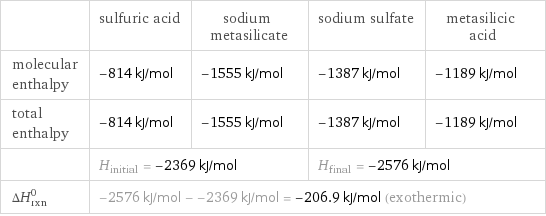
| sulfuric acid | sodium metasilicate | sodium sulfate | metasilicic acid molecular enthalpy | -814 kJ/mol | -1555 kJ/mol | -1387 kJ/mol | -1189 kJ/mol total enthalpy | -814 kJ/mol | -1555 kJ/mol | -1387 kJ/mol | -1189 kJ/mol | H_initial = -2369 kJ/mol | | H_final = -2576 kJ/mol | ΔH_rxn^0 | -2576 kJ/mol - -2369 kJ/mol = -206.9 kJ/mol (exothermic) | | |
Gibbs free energy
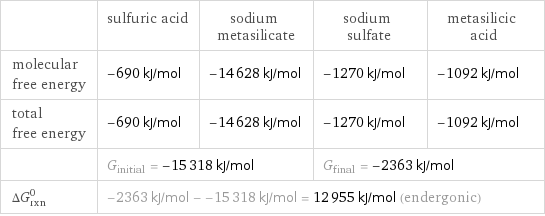
| sulfuric acid | sodium metasilicate | sodium sulfate | metasilicic acid molecular free energy | -690 kJ/mol | -14628 kJ/mol | -1270 kJ/mol | -1092 kJ/mol total free energy | -690 kJ/mol | -14628 kJ/mol | -1270 kJ/mol | -1092 kJ/mol | G_initial = -15318 kJ/mol | | G_final = -2363 kJ/mol | ΔG_rxn^0 | -2363 kJ/mol - -15318 kJ/mol = 12955 kJ/mol (endergonic) | | |
Equilibrium constant
![Construct the equilibrium constant, K, expression for: H_2SO_4 + Na_2SiO_3 ⟶ Na_2SO_4 + H_2O_3Si Plan: • Balance the chemical equation. • Determine the stoichiometric numbers. • Assemble the activity expression for each chemical species. • Use the activity expressions to build the equilibrium constant expression. Write the balanced chemical equation: H_2SO_4 + Na_2SiO_3 ⟶ Na_2SO_4 + H_2O_3Si Assign stoichiometric numbers, ν_i, using the stoichiometric coefficients, c_i, from the balanced chemical equation in the following manner: ν_i = -c_i for reactants and ν_i = c_i for products: chemical species | c_i | ν_i H_2SO_4 | 1 | -1 Na_2SiO_3 | 1 | -1 Na_2SO_4 | 1 | 1 H_2O_3Si | 1 | 1 Assemble the activity expressions accounting for the state of matter and ν_i: chemical species | c_i | ν_i | activity expression H_2SO_4 | 1 | -1 | ([H2SO4])^(-1) Na_2SiO_3 | 1 | -1 | ([Na2SiO3])^(-1) Na_2SO_4 | 1 | 1 | [Na2SO4] H_2O_3Si | 1 | 1 | [H2O3Si] The equilibrium constant symbol in the concentration basis is: K_c Mulitply the activity expressions to arrive at the K_c expression: Answer: | | K_c = ([H2SO4])^(-1) ([Na2SiO3])^(-1) [Na2SO4] [H2O3Si] = ([Na2SO4] [H2O3Si])/([H2SO4] [Na2SiO3])](../image_source/9c8d3c0643c945e5893e7d24d6636786.png)
Construct the equilibrium constant, K, expression for: H_2SO_4 + Na_2SiO_3 ⟶ Na_2SO_4 + H_2O_3Si Plan: • Balance the chemical equation. • Determine the stoichiometric numbers. • Assemble the activity expression for each chemical species. • Use the activity expressions to build the equilibrium constant expression. Write the balanced chemical equation: H_2SO_4 + Na_2SiO_3 ⟶ Na_2SO_4 + H_2O_3Si Assign stoichiometric numbers, ν_i, using the stoichiometric coefficients, c_i, from the balanced chemical equation in the following manner: ν_i = -c_i for reactants and ν_i = c_i for products: chemical species | c_i | ν_i H_2SO_4 | 1 | -1 Na_2SiO_3 | 1 | -1 Na_2SO_4 | 1 | 1 H_2O_3Si | 1 | 1 Assemble the activity expressions accounting for the state of matter and ν_i: chemical species | c_i | ν_i | activity expression H_2SO_4 | 1 | -1 | ([H2SO4])^(-1) Na_2SiO_3 | 1 | -1 | ([Na2SiO3])^(-1) Na_2SO_4 | 1 | 1 | [Na2SO4] H_2O_3Si | 1 | 1 | [H2O3Si] The equilibrium constant symbol in the concentration basis is: K_c Mulitply the activity expressions to arrive at the K_c expression: Answer: | | K_c = ([H2SO4])^(-1) ([Na2SiO3])^(-1) [Na2SO4] [H2O3Si] = ([Na2SO4] [H2O3Si])/([H2SO4] [Na2SiO3])
Rate of reaction
![Construct the rate of reaction expression for: H_2SO_4 + Na_2SiO_3 ⟶ Na_2SO_4 + H_2O_3Si Plan: • Balance the chemical equation. • Determine the stoichiometric numbers. • Assemble the rate term for each chemical species. • Write the rate of reaction expression. Write the balanced chemical equation: H_2SO_4 + Na_2SiO_3 ⟶ Na_2SO_4 + H_2O_3Si Assign stoichiometric numbers, ν_i, using the stoichiometric coefficients, c_i, from the balanced chemical equation in the following manner: ν_i = -c_i for reactants and ν_i = c_i for products: chemical species | c_i | ν_i H_2SO_4 | 1 | -1 Na_2SiO_3 | 1 | -1 Na_2SO_4 | 1 | 1 H_2O_3Si | 1 | 1 The rate term for each chemical species, B_i, is 1/ν_i(Δ[B_i])/(Δt) where [B_i] is the amount concentration and t is time: chemical species | c_i | ν_i | rate term H_2SO_4 | 1 | -1 | -(Δ[H2SO4])/(Δt) Na_2SiO_3 | 1 | -1 | -(Δ[Na2SiO3])/(Δt) Na_2SO_4 | 1 | 1 | (Δ[Na2SO4])/(Δt) H_2O_3Si | 1 | 1 | (Δ[H2O3Si])/(Δt) (for infinitesimal rate of change, replace Δ with d) Set the rate terms equal to each other to arrive at the rate expression: Answer: | | rate = -(Δ[H2SO4])/(Δt) = -(Δ[Na2SiO3])/(Δt) = (Δ[Na2SO4])/(Δt) = (Δ[H2O3Si])/(Δt) (assuming constant volume and no accumulation of intermediates or side products)](../image_source/8aa6cf834b33897da134527a168bab09.png)
Construct the rate of reaction expression for: H_2SO_4 + Na_2SiO_3 ⟶ Na_2SO_4 + H_2O_3Si Plan: • Balance the chemical equation. • Determine the stoichiometric numbers. • Assemble the rate term for each chemical species. • Write the rate of reaction expression. Write the balanced chemical equation: H_2SO_4 + Na_2SiO_3 ⟶ Na_2SO_4 + H_2O_3Si Assign stoichiometric numbers, ν_i, using the stoichiometric coefficients, c_i, from the balanced chemical equation in the following manner: ν_i = -c_i for reactants and ν_i = c_i for products: chemical species | c_i | ν_i H_2SO_4 | 1 | -1 Na_2SiO_3 | 1 | -1 Na_2SO_4 | 1 | 1 H_2O_3Si | 1 | 1 The rate term for each chemical species, B_i, is 1/ν_i(Δ[B_i])/(Δt) where [B_i] is the amount concentration and t is time: chemical species | c_i | ν_i | rate term H_2SO_4 | 1 | -1 | -(Δ[H2SO4])/(Δt) Na_2SiO_3 | 1 | -1 | -(Δ[Na2SiO3])/(Δt) Na_2SO_4 | 1 | 1 | (Δ[Na2SO4])/(Δt) H_2O_3Si | 1 | 1 | (Δ[H2O3Si])/(Δt) (for infinitesimal rate of change, replace Δ with d) Set the rate terms equal to each other to arrive at the rate expression: Answer: | | rate = -(Δ[H2SO4])/(Δt) = -(Δ[Na2SiO3])/(Δt) = (Δ[Na2SO4])/(Δt) = (Δ[H2O3Si])/(Δt) (assuming constant volume and no accumulation of intermediates or side products)
Chemical names and formulas
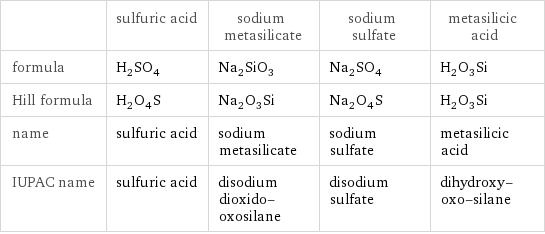
| sulfuric acid | sodium metasilicate | sodium sulfate | metasilicic acid formula | H_2SO_4 | Na_2SiO_3 | Na_2SO_4 | H_2O_3Si Hill formula | H_2O_4S | Na_2O_3Si | Na_2O_4S | H_2O_3Si name | sulfuric acid | sodium metasilicate | sodium sulfate | metasilicic acid IUPAC name | sulfuric acid | disodium dioxido-oxosilane | disodium sulfate | dihydroxy-oxo-silane
Substance properties
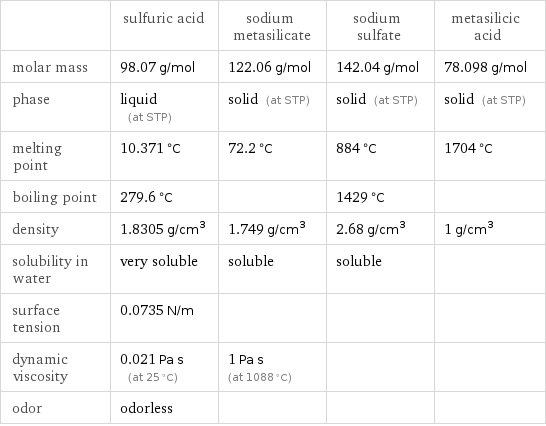
| sulfuric acid | sodium metasilicate | sodium sulfate | metasilicic acid molar mass | 98.07 g/mol | 122.06 g/mol | 142.04 g/mol | 78.098 g/mol phase | liquid (at STP) | solid (at STP) | solid (at STP) | solid (at STP) melting point | 10.371 °C | 72.2 °C | 884 °C | 1704 °C boiling point | 279.6 °C | | 1429 °C | density | 1.8305 g/cm^3 | 1.749 g/cm^3 | 2.68 g/cm^3 | 1 g/cm^3 solubility in water | very soluble | soluble | soluble | surface tension | 0.0735 N/m | | | dynamic viscosity | 0.021 Pa s (at 25 °C) | 1 Pa s (at 1088 °C) | | odor | odorless | | |
Units
